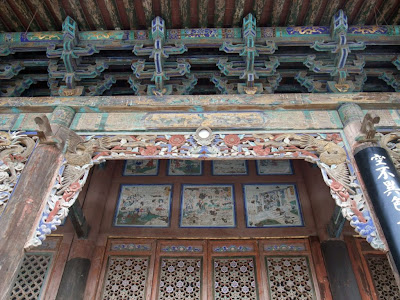
The Temple of Blessed Nation Youguo-si (万圣佑国寺) was constructed under the order of Emperor Yuancheng-Zong (元成宗) in year 1296 when he visited Wutaishan and believed that the aureola he met was the halo light of Bodhisattva Manjushri. The first Abbot appointed by the Emperor was a national Senior Dharma Master Zhen-Jue-Guoshi (高僧真觉国师) who was capable, knowledgeable and proficient in Dharma. The Master was so vigor in cultivation that he once meditated under pine forest and forgot to go back to the temple for 3 days. In memory to The Master after he passed away in year 1302, Emperor Yuan-Renzong (1312-1321) built a stupa for him in the temple site. He left behind hundreds of crystal relics after cremation. Followed by Master Zhen-Jue, another reputed Abbot of Youguo-si was Great Master Rev. Hong-Jiao (高僧弘教大师) who specialized in the teachings of Avatamsaka Sutra. He was appointed by Emperor Yuan Yin-Zong (1321-1324) to manage the temple. In year 1322, when Master Hong-Jiao entered in meditation during the nation blessing assembly in the temple, Emperor eye-witness beams of white light appeared in the sky with image of Bodhisattva Manjushri. The Majesty was full of bliss and bestowed him with money, Bodhisattva Jade figures, jewel beads and an official honor title but it was refused by the monk. Master Hong-Jiao passed away in year 1337 and his relics were kept in the Stupa. The transcendent personality of the two masters had deeply injected into the principal spirit of Nanshan-si that continued for thousand years.


Temple of Youguo-si is at the top terraces of Nanshan-si. It has three layers of courts with main shrine halls, namely Leiyin Jewel Hall (雷音宝殿), Maha Vihara Hall (大雄宝殿) and Pilu Buddha Hall (毗卢大殿). Leiyin Hall enshrines with an image of future Buddha Maitreya made from white marble and there have 317 pieces of stone carving arts along the left and right side of the entrance gate and on the building structure. Contents mainly focus on the historical legend of Three Kingdom. Maha Vihara Hall is at the 2nd court where 451 pieces of stone arts carved with historical stories were placed. Image of Buddha Sakyamuni is enshrined inside Maha Vihara Hall. The 3rd layer of court is where the Pilu Buddha Hall located. It enshrines an image of Buddha Pilu. By both sides of the Buddha image, there are 13 pairs plus 36 units of components belonging to the half unit of imperial chariot, which was a gift from Express Dowaka Cixi present to the past Abbot, Master Puji during Qing Dynasty. The 345 pieces of stone engraving arts at this 3rd court mainly focus on Chinese folk legends and history.



Youguo-si is a treasure house of stone carved arts. Within its three layers of courts, there are 1482 pieces of stone engraving arts with contents of local fauna and floral, the Chinese folk legends and historical stories. Each piece was skillfully carved with postures and expressions. They are precise, gorgeous and indeed work of superior standard.



Visit the halls at its three courtyards.



The splendid wood carvings at Main Shrine Hall.



The wooden doors and windows of the Halls are adorned with beautiful carving pictures.



The amazing wood carving arts.


Interesting and attractive!


Every carved wooden door top carries a striking sentence that brighten one's mind and bring up one's awareness. The four words written on these two are "看破放下 Give way and Let Go" and "发菩提心 Bringing Forth the Bodhi Resolve" which means vow to generate a Bodhi seed in mind to become enlightened.


Majority of the doors at the Halls have beautiful lattice designs.



A stunning carved stone pillar and building of main shrine hall.



Hardly can find structure that is without carving designs. Carving arts appear every where on its doors, its pillars, its veranda, its walls, stairs, walls, eaves and roofs.



Abundant stone carving arts are found along the sides and edges of white marble platforms that were built within layers of courts in front of shrine halls. The 316 designs focus mainly on people, fauna and floral like cherry flower, peony, bamboo, peach, phoenix, dragon, lion, deer, horses, storks, birds etc. Appreciate the volunteer Dharma worker's explanation given me an understanding to some of its special and outstanding pieces.



Looking forward to the next court.



There are five units of standing stone carved arts at the two sides of its white marble platform within the courts. People are the main content of these stone carving arts. The Three Gods of Blessing, Prosperity and Longevity were carved at the center wall, and by its side are four elders representing "Music, Chess, Book and Painting" The north end at the edge was carved with Woman hero Mu-guiying and at south edge the carving focus on two seniors with its 4 soldiers protectors. All people carved were related to historic legends or mythological stories.



The art piece that carved with three Gods of Blessing, Prosperity and Longevity and the Supreme God of Taoism Tai-shang Lao-jun (太上老君)。


The stone carving arts of 9-dragons, phoenix and bats are most amazing. The three wholesome and lucky animals were carved on the ground. People threw coins to look for blessing.



Awesome!


The carving contents at this side mainly are flowers.



The 20th century products of stone engraving pieces in Temple Youguo-si are of high arts value. The pictures were carved with professional technique and skill. They are precise and fine.



This is a true stone engraving world, a true gallery of carving arts.



An ocean of stone carving arts.



The abundant white marble carving art pieces are amazing.



The contents of carving pieces in Temple Youguo-si not only versatile but of super quality and high standard.







Temple Youguo-si offers fantastic view to the 4 mountain peaks of Wutaishan.


Snow-capped North mountain peak is the highest peak in the northern region of China.


The scenic sight of its valley.



No comments:
Post a Comment